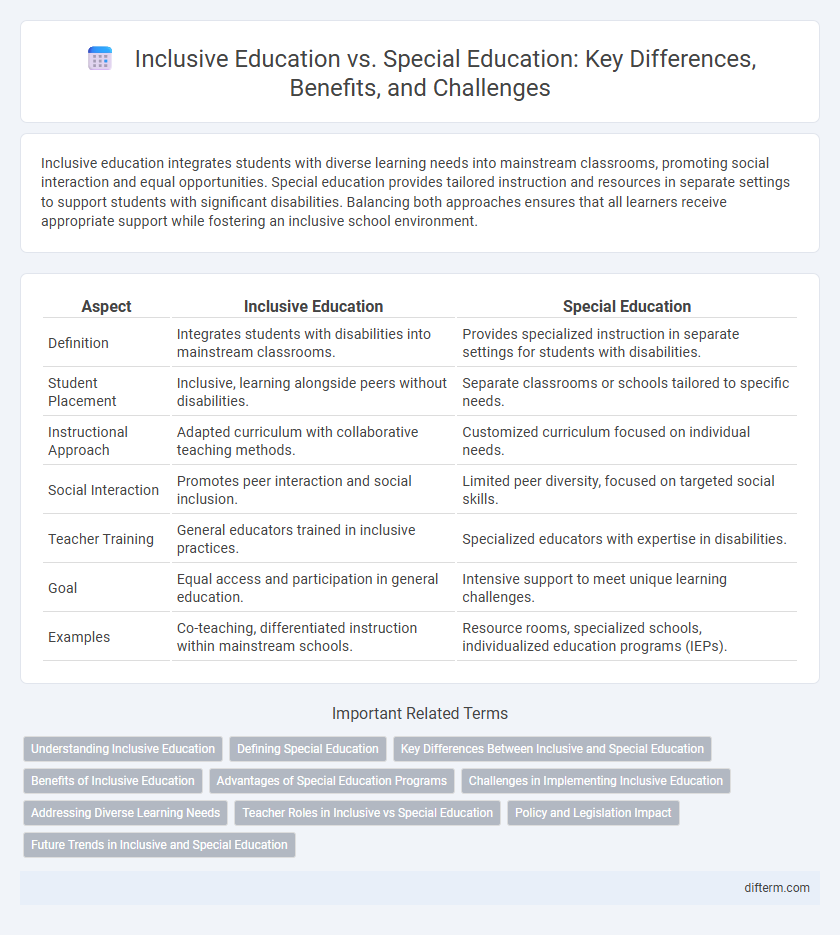Inclusive education integrates students with diverse learning needs into mainstream classrooms, promoting social interaction and equal opportunities. Special education provides tailored instruction and resources in separate settings to support students with significant disabilities. Balancing both approaches ensures that all learners receive appropriate support while fostering an inclusive school environment.
Table of Comparison
| Aspect | Inclusive Education | Special Education |
|---|---|---|
| Definition | Integrates students with disabilities into mainstream classrooms. | Provides specialized instruction in separate settings for students with disabilities. |
| Student Placement | Inclusive, learning alongside peers without disabilities. | Separate classrooms or schools tailored to specific needs. |
| Instructional Approach | Adapted curriculum with collaborative teaching methods. | Customized curriculum focused on individual needs. |
| Social Interaction | Promotes peer interaction and social inclusion. | Limited peer diversity, focused on targeted social skills. |
| Teacher Training | General educators trained in inclusive practices. | Specialized educators with expertise in disabilities. |
| Goal | Equal access and participation in general education. | Intensive support to meet unique learning challenges. |
| Examples | Co-teaching, differentiated instruction within mainstream schools. | Resource rooms, specialized schools, individualized education programs (IEPs). |
Understanding Inclusive Education
Inclusive education fosters a learning environment where students of all abilities learn together, promoting diversity and equal opportunities within mainstream classrooms. It emphasizes personalized support and accessible curriculum to accommodate various learning needs, reflecting a shift from segregation toward integration. Understanding inclusive education involves recognizing its role in enhancing social interaction, academic achievement, and acceptance among students with disabilities compared to traditional special education settings.
Defining Special Education
Special education refers to customized instructional programs designed to meet the unique needs of students with disabilities, including learning, physical, intellectual, or emotional challenges. It involves specialized teaching methods, adaptive materials, and support services tailored to enhance individual learning outcomes. In contrast to inclusive education, which integrates students with diverse abilities into general classrooms, special education often takes place in dedicated settings to provide targeted interventions.
Key Differences Between Inclusive and Special Education
Inclusive education integrates students with diverse abilities into general classrooms, promoting social interaction and equal access to curriculum, while special education provides tailored instruction in separate or specialized settings designed to meet individual needs. Key differences include placement options, teaching methods, and collaboration levels; inclusive education emphasizes universal design and peer support, whereas special education focuses on individualized goals and specialized resources. Both approaches aim to enhance learning outcomes but differ fundamentally in their educational environment and support structures.
Benefits of Inclusive Education
Inclusive education fosters a diverse learning environment where students with and without disabilities learn together, promoting social integration and reducing stigma. It enhances academic outcomes by encouraging differentiated instruction tailored to individual needs, benefiting all learners. This approach develops empathy, collaboration, and communication skills, preparing students for real-world interactions in diverse societies.
Advantages of Special Education Programs
Special education programs offer tailored instructional strategies and resources designed to meet the unique learning needs of students with disabilities, enhancing their academic achievement and social development. These programs provide individualized support, such as speech therapy, occupational therapy, and adaptive technology, which are essential for promoting independence and skill acquisition. Access to specially trained educators and customized curricula ensures that students receive effective interventions fostering confidence and long-term success.
Challenges in Implementing Inclusive Education
Implementing inclusive education faces significant challenges such as inadequate teacher training, insufficient resources, and lack of infrastructure tailored to diverse learning needs. Schools often struggle with balancing curriculum standards while accommodating students with disabilities or special needs, resulting in uneven educational outcomes. Overcoming social stigma and fostering collaboration among educators, families, and communities remain critical hurdles to effective inclusive education.
Addressing Diverse Learning Needs
Inclusive education integrates students with diverse learning needs into general classrooms, fostering social interaction and equal access to the curriculum. Special education provides tailored instruction and resources for students with specific disabilities, ensuring individualized support. Both approaches aim to address diverse learning needs but differ in setting, teaching methods, and focus on integration versus specialized assistance.
Teacher Roles in Inclusive vs Special Education
Teachers in inclusive education adapt their instructional strategies to accommodate diverse learning needs within general classrooms, fostering collaboration and peer support. In special education, teachers design individualized education programs (IEPs) and employ specialized techniques tailored to students with specific disabilities. Both roles require expertise in differentiated instruction, but inclusive educators emphasize integration, while special educators focus on targeted interventions.
Policy and Legislation Impact
Inclusive education policies promote equal access and participation for all students within mainstream classrooms, driven by international frameworks such as the UN Convention on the Rights of Persons with Disabilities. Special education legislation often emphasizes tailored support and individualized education plans (IEPs), ensuring students with disabilities receive appropriate resources and services. The impact of these policies shapes school infrastructure, teacher training, and resource allocation to foster environments that accommodate diverse learning needs.
Future Trends in Inclusive and Special Education
Future trends in inclusive and special education emphasize the integration of advanced technologies such as AI-driven learning tools and adaptive software to support diverse learner needs. Personalized learning pathways and data analytics will enable educators to tailor instruction, enhancing engagement and outcomes for students with disabilities. Collaboration between general and special educators will increase, promoting more holistic and flexible educational environments that prioritize equity and accessibility.
inclusive education vs special education Infographic

 difterm.com
difterm.com